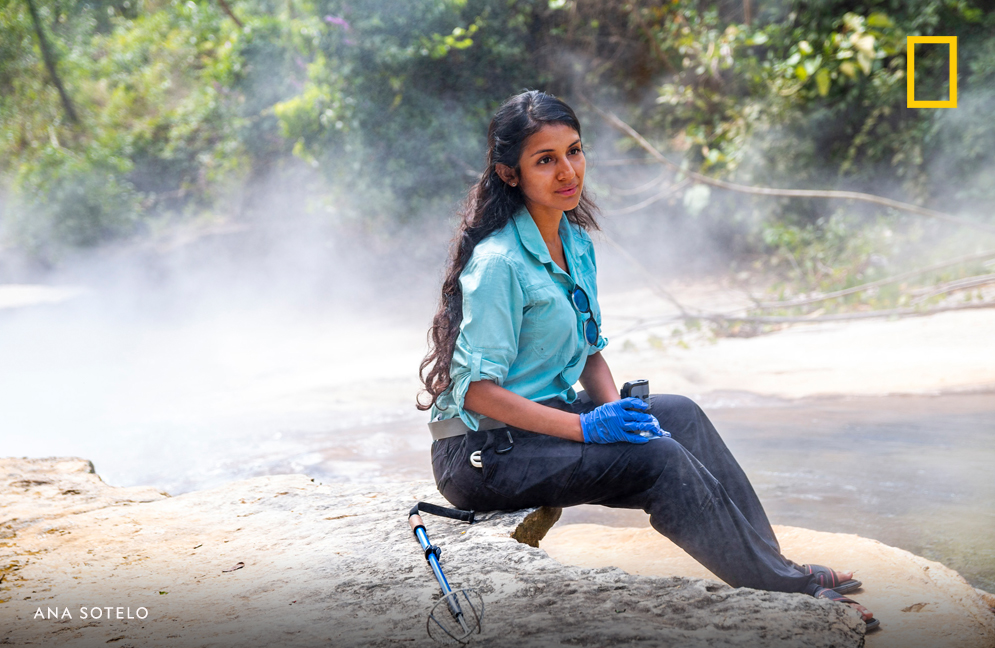
Every week throughout #WomensHistoryMonth, we'll be passing the mic to someone from the @NatGeo family who will be highlighting an aspect of women's history or their work. Today we'll be hearing from Chemical Biologist @rosavespinoza. 1/19
There is a hidden world deep in the Amazon Rainforest that we only recently began to explore. Understanding it could help us better protect our endangered jungle, teach us about evolution of Amazonian life and EVEN... 2/19 

...advance medicine and biotechnology that could change life as we know it. I'm NatGeo Explorer & Chemical Biologist @rosavespinoza—let's explore the fascinating microscopic universe of the Amazon! 3/19 

Invisible to the naked eye, microbes are microscopic organisms that are found everywhere: air, water, soil, trees, animals, humans. These tiny life forms are essential for our health and the planet's. Some are so unique that they can even flourish in extreme conditions... 4/19 

...considered inhospitable for life—think boiling/freezing waters, acid, radiation, high pressure like in deep ocean trenches, toxic waste & even space (see tardigrades!). Known as extremophiles, these microbes have arguably been humanity's "best-friend" in the modern era. 5/19
They've helped us "hack" genetic codes allowing us to make new medicines, materials & figure out our ancestry. A heat-resistant microbe discovered in the boiling waters of Yellowstone is even helping us test for COVID-19. What can happen if we study a "hot bed of life" in... 6/19 

...one of the world's richest biodiversity regions? The Amazon's microbiome supports the magnificent macroscopic life that makes up the jungle's mega-diversity (trees, flowers, animals). Yet we often forget about this hidden Amazonian universe. So most remains unexplored. 7/19 

Until now. Along with an extraordinary team @georuzo, we are exploring the Boiling River of the Peruvian Amazon, one of the world's largest thermal rivers. Pre-pandemic, we trekked deep into the jungle to look for the unique microbes thriving in these boiling waters. 8/19 



With @microamazon, we study Amazonian extremophiles at @davidhsumich lab in @UMLifeSciences, where I complete my Ph.D. As a first step, we're documenting unexplored species & dissecting their chemistry to understand how they can survive at brutal temperatures. Ultimately... 9/19 

...we'll create the 1st local microbial database to facilitate Amazonian research. We must study the Amazonia as a whole & incorporate microbial knowledge in conservation strategies so that we have a fighting change in preserving it & ensure a healthy future for our planet. 10/19 

Otherwise, how can we protect what we don't understand? 11/19
Growing up in Perú, my grandmother instilled in me a profound sense of respect and love for nature. In spite of not knowing how to read or write, she taught me education is our greatest hope in protecting our Pachamama (Mother Earth). So now I honor nature through science. 12/19 

As the first scientist in my family, I didn't have a scientist role model I could relate to when I was little. Somebody that looked and spoke like me. So I'm thrilled that voices are getting amplified. Because representation drives change, and diversity inspires innovation. 13/19
I admire many extraordinary scientists & today I'd like to highlight some of them:
1) Dr. @peixotors for her outstanding work in developing marine probiotics to protect coral reefs.
2) Dr. Gretty Villena-Chávez for her leading work in bioprospecting and engineering fungi. 14/19
1) Dr. @peixotors for her outstanding work in developing marine probiotics to protect coral reefs.
2) Dr. Gretty Villena-Chávez for her leading work in bioprospecting and engineering fungi. 14/19

3) @RutEqp for creating KillaLab that planned on sending a mini lab to the moon.
4) Dr. Julia Tejada for her incredible discoveries in the evolution of Amazonian mammals.
5) @FromCaliToMars for hunting life on Mars & reminding us that anything is possible with hard work. 15/19
4) Dr. Julia Tejada for her incredible discoveries in the evolution of Amazonian mammals.
5) @FromCaliToMars for hunting life on Mars & reminding us that anything is possible with hard work. 15/19

I also admire every parent & educator raising the next generation of scientists worldwide, especially during this pandemic. An incredible example is Reyna Meza Montes' story from Perú. Her 3 children dream of becoming a mechanical engineer, a medical scientist & a chef. 16/19 

She works many jobs to make these dreams come true. But when COVID-19 hit, her family & community battled food insecurity. Determined to survive, Reyna organized the women in her town to start a local soup kitchen that now feeds 100+ people daily—including their children. 17/19 

There are many heroes out there working nonstop to make our world better. To advance humanity. To protect nature. Yet they often go unrecognized. So let's amplify their voices. Let's catalyze positive change by telling stories. For a joyful and inspired #WomensHistoryMonth! 18/19 

Thank you to @rosavespinoza for sharing her story! And learn more about her work here: 19/19
CORRECTION: This photo had the wrong credit earlier in this thread. We are attaching the image with the correct photo credit. 

• • •
Missing some Tweet in this thread? You can try to
force a refresh





